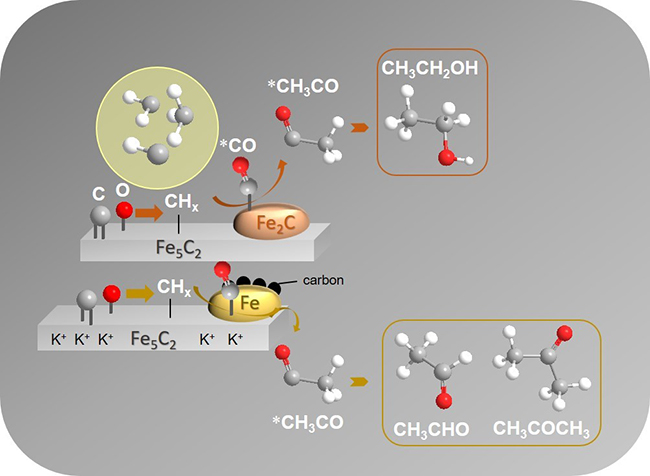Scientists Realize Direct Conversion of Syngas into Higher Aldehydes and Ketones under Mild Condition
Higher oxygenates, typically referred to alcohols, aldehydes and ketones, are widely used valuable chemicals.
Compared with traditional routes, the direct synthesis of higher oxygenates from syngas is a facile and eco-friendly process. However, the low oxygenate yield and active hydrogenation of aldehyde and ketone in this process restrict its industrial applications.
Recently, a research team led by Prof. SUN Jian and Prof. GE Qingjie from the Dalian Institute of Chemical Physics (DICP) of the Chinese Academy of Sciences (CAS) has prepared unsaturated oxygenates from syngas and achieved the highly selective production of higher aldehydes and ketones from CO hydrogenation under a mild condition over alkali metal modified iron catalysts.
This study was published in Applied Catalysis B: Environmental on Jan. 29.

Illustration for the reaction pathway of oxygenates production over Fe-based catalysts (Image by XU Jing)
The proposed alkali metal modified iron catalysts, which are synergistic Fe-K series catalysts, could realize the regulation of CO hydrogenation products to C2+ alcohols or C2+ aldehydes and ketones under a mild condition. At a mild temperature of 170°C, the oxygenate selectivity was up to nearly 70 wt%, 88% of which were aldehydes and ketones.
The characterizations results showed that the shift of aldehyde-ketone and alcohol was closely related to the electronic and structural effect of K promoter. Proper K promoter could adjust surface chemical environment of catalyst (C-rich and H-lean surface) and reaction intermediates for alcohol to aldehyde shift.
The researchers found that the CO non-dissociative sites from Fe2C to Fe by the addition of K could reduce the energy barrier of aldehyde formation, which was favorable for aldehyde production.
"This study provides a new idea for the design and application of catalysts to tune the different higher oxygenate distribution in CO hydrogenation," said Prof. SUN.
This work was supported by the National Natural Science Foundation of China, the Youth Innovation Promotion Association of CAS, and Liaoning Revitalization Talents Program. (Text by XU Jing)